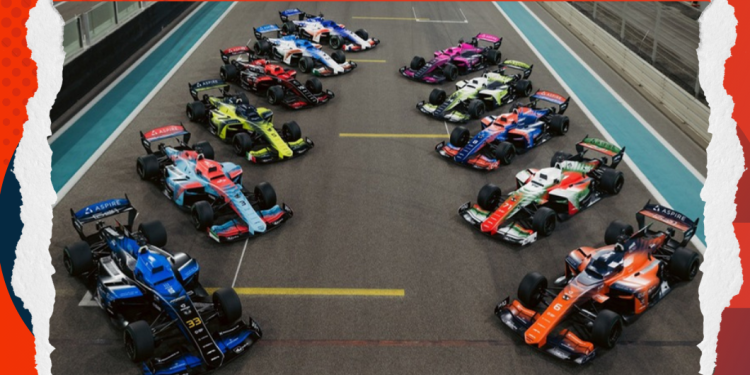On November 15, 2024, Abu Dhabi made motorsport history with the world’s first multi-car driverless Grand Final, featuring six fully autonomous racing cars competing wheel-to-wheel. The Abu Dhabi Autonomous Racing League (A2RL) Season 2 delivered dramatic overtakes, high-speed crashes, and split-second AI decision-making that left 20,000 spectators at Yas Marina Circuit on the edge of their seats.
Germany’s Technical University of Munich (TUM) claimed its second consecutive championship after rival Unimore crashed while leading the 20-lap race. The competition featured 11 international teams battling for a $2.25 million prize pool, with artificial intelligence pushing the boundaries of what machines can achieve at speeds exceeding 155 mph.
TUM Retains Championship After Dramatic Mid-Race Collision
The Grand Final started with pole-sitter TUM holding the lead until lap two, when Italy’s Unimore executed a daring inside overtake at 200+ mph speeds. The AI-powered cars demonstrated racing intelligence that matched human drivers, making split-second decisions while navigating through traffic at breakneck speeds.
Unimore appeared destined for victory until Constructor, a back-marker car, suffered mechanical failure mid-corner. The leading Unimore vehicle attempted evasive action but clipped the stationary car, sliding off track with front-end damage and ending their championship hopes.
After a full-course yellow flag restart, TUM regained control and held their position through the checkered flag. The victory secured their place as the first back-to-back A2RL champions and earned them the largest share of the prize money.
Human vs AI Performance Gap Shrinks to Historic Low
The most compelling demonstration came during the Human vs AI showcase, where former Formula 1 driver Daniil Kvyat faced off against TUM’s autonomous system. The results shocked motorsport experts and technology enthusiasts alike.
Kvyat’s human-driven lap time of 57.5 seconds barely edged out the AI’s 59.13-second performance – a gap of just 1.6 seconds. This represents a massive leap from A2RL’s inaugural season, when human drivers held advantages measured in minutes rather than seconds.
“Looking back to when A2RL development first began a couple of years ago, with perhaps minutes between a human driver and the AI car, down to 10 seconds in our first showcase last year, and now the gap is dramatically reduced again to fractions of a second – the progress is staggering,” Kvyat commented after the exhibition.
Six Teams Demonstrate Advanced Racing Intelligence
The Grand Final featured six qualifying teams: TUM (Germany), Unimore (Italy), Kinetiz (Germany), TII Racing (UAE), PoliMOVE (Italy), and Constructor (UAE). Each autonomous system operated with distinct programming philosophies, creating varied racing personalities and strategic approaches.
During qualification rounds in October, the Italian team Unimore became the first autonomous vehicle to beat benchmark lap times set by human racing drivers. This milestone demonstrated that AI systems could not only match but potentially exceed human performance in controlled racing environments.
The race showcased advanced AI capabilities, including real-time obstacle detection, dynamic line optimisation, and strategic overtaking manoeuvers. Teams programmed their vehicles to balance speed with safety, creating racing algorithms capable of making split-second decisions that would challenge even experienced human drivers.
Technology Push Accelerates Autonomous Vehicle Development
A2RL Season 2 marked a significant technological advancement over the inaugural 2024 event. The 18-month development period between seasons produced measurable improvements in AI racing performance, with teams consistently achieving faster lap times and more reliable racing systems.
Prof. Dr.-Ing. Markus Lienkamp, TUM Team Principal, explained their strategic approach: “We wanted to be a bit safe with our algorithms on cold tires, but Unimore was getting faster and faster. We expected they’d overtake us on lap 2, which they did.”
The competition serves as a real-world testing ground for autonomous vehicle technology that could accelerate development in consumer self-driving cars. Racing environments push AI systems to their operational limits, generating valuable data for improving safety algorithms and decision-making processes in high-stress scenarios.
Silver Race Provides Platform for Emerging Teams
Five additional teams competed in the Silver Race time trials: RAPSON, Code 19, Fly Eagle, FR4IAV, and TGM Grand Prix. TGM Grand Prix secured victory in this secondary competition, demonstrating the depth of talent developing in autonomous racing technology.
The Silver Race format allowed teams to push their algorithms to maximum performance without the complexity of multi-car interactions. This approach provided valuable testing opportunities for teams still refining their racing systems while building experience for future Grand Final qualification.
Global Broadcasting Reaches Millions of Technology Enthusiasts
A2RL Season 2 reached audiences worldwide through Abu Dhabi Media Network, StarzPlay, Motorsport TV, and the official A2RL YouTube Channel. The event also featured immersive VR broadcasting that allowed viewers to experience real-time car data and track perspectives from multiple angles.
Fan engagement extended beyond traditional broadcasting through interactive displays at Yas Marina Circuit. The Fan Zone featured humanoid robot showcases, hands-on technology demonstrations, and educational activities that connected autonomous racing with artificial intelligence applications.
UAE Positions Itself as Global AI Innovation Hub
The event reinforced Abu Dhabi’s commitment to becoming a leading center for artificial intelligence research and development. A2RL operates under the guidance of the UAE’s Advanced Technology Research Council (ATRC), with H.E. Faisal Al Bannai, Adviser to the UAE President, providing strategic vision for the program.
ASPIRE CEO Stephane Timpano emphasized the educational value: “What happened tonight is not only amazing – it’s the result of very hard work that has been done by all the teams, and by the technical team of A2RL who’ve pushed the technology so hard over the last 18 months.”
The championship also featured the A2RL STEM Competition, involving 140 students from all seven emirates racing AWS DeepRacer 1/18th-scale autonomous cars. This educational component builds future talent pipelines in artificial intelligence and autonomous systems development.
Looking Forward to A2RL Season 3
Teams departed Abu Dhabi with extensive performance data and renewed determination to push the boundaries of autonomous racing further. The 2026 season promises even more advanced AI capabilities as teams incorporate lessons learned from Season 2’s dramatic competition.
The rapid progression from concept to competitive racing demonstrates how quickly artificial intelligence can evolve when tested in extreme real-world conditions. A2RL continues to establish new benchmarks for autonomous vehicle performance while entertaining audiences with high-speed racing action that was once thought impossible without human drivers.
As the gap between human and artificial intelligence performance continues narrowing, A2RL provides a glimpse into a future where autonomous vehicles may not just match human capabilities but potentially exceed them in precision, consistency, and safety.














